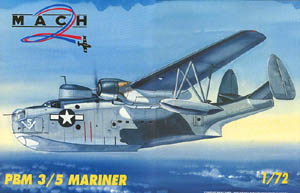Mach 2 1/ 72 Martin
PBM 3/5 Mariner | | History The history of the Mariner is an interesting one and it's not an easy one to compress down into just a couple paragraphs. Rather than try to do that, the author wrote a comprehensive history on the type that can be found here. The Kit 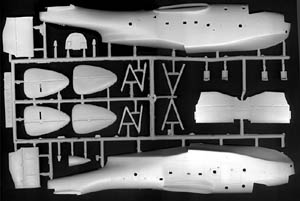 Perhaps it would be best if I said right up front that in the past I have not been much of a Mach 2 fan. Oh, they have produced models of some of my all time favorite airplanes. In fact they seem to do it regularly. But generally they are poorly done and overpriced. I have often said they are the “spoilers” of the plastic kit industry. They take on marginal subjects that are high on the want list of serious modelers but would not generally do well in the plastic mass market. They then “spoil” the market for anyone who would/could do a better job. Sad to say, I am probably typical of most modelers. My stash has one of about everything U.S. that Mach 2 has ever done, and I hate every one of them. But my chances of ever seeing a “better” kit are slim. I know it and keep buying Mach 2 at inflated prices because of it. Perhaps it would be best if I said right up front that in the past I have not been much of a Mach 2 fan. Oh, they have produced models of some of my all time favorite airplanes. In fact they seem to do it regularly. But generally they are poorly done and overpriced. I have often said they are the “spoilers” of the plastic kit industry. They take on marginal subjects that are high on the want list of serious modelers but would not generally do well in the plastic mass market. They then “spoil” the market for anyone who would/could do a better job. Sad to say, I am probably typical of most modelers. My stash has one of about everything U.S. that Mach 2 has ever done, and I hate every one of them. But my chances of ever seeing a “better” kit are slim. I know it and keep buying Mach 2 at inflated prices because of it.
That is pretty strong criticism I know, but I am also pretty sure it reflects the opinions of most of the modelers I know. So having established where I stand, how did Mach 2 do this time? My first impression, on opening the box is that this is a big bird! With a wingspan of 118’ and a length of almost 80’ it is over two scale inches longer in wingspan than a Catalina, and 2 ˝ inches longer as well. To get a further size comparison, this 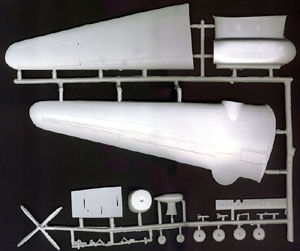 thing has a wingspan eight feet longer than a B-24, and 14 feet longer than a B-17. Heck, the wingspan is only two feet short of a B-47. As I said above, the deep fuselage makes it look even bigger. thing has a wingspan eight feet longer than a B-24, and 14 feet longer than a B-17. Heck, the wingspan is only two feet short of a B-47. As I said above, the deep fuselage makes it look even bigger. The parts are separated into three large trees and two smaller trees of the usual Mach 2 light gray plastic. Also included is one very busy tree of clear (?) parts. The gray components are generally better done than the past Mach 2 kits. The “pebble like” surface appearance is much better with this one. Also much less apparent are the warps and dips and bows of previous efforts. The upper left elevator on my kit has a rather unusual bulge in the middle, and one rudder trailing edge is a bit fatter than the area above and below it, but for the most part the pieces seem to be shaped pretty well. There are surface blemishes and dings on this that seem unique to Mach 2 kits. I have not seen them on most other manufacturer’s kits. This one has several small blobs of plastic that look like they were just dropped onto the surface. Obviously melted into the surface with no distortion around them, but firmly adhered to the plastic. Removing them is not hard, just a mystery as to why/how they got there. Another oddity is an area about ˝ inch long on the lower surface of the right hand wing. The best description I can come up with is it looks like a blacktop road seam on a really hot summer day. The seam has erupted upward about .10 thou. Again, not a big thing to fix, just odd. 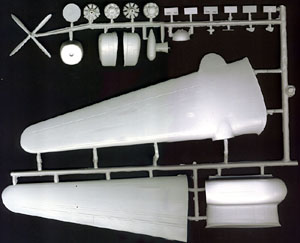 Now for some good news. The scribing on this kit is much better than previous kits. In fact I think it is pretty darn good. The fuselage surface detail is nice. A combination of indented round and square tie downs/hand holds good scribed panel lines and the spoiler in front of the waist gun position are impressive. The scribing has a much crisper edge than in the past, and they are uniform in depth and width. Also missing are the panel lines that either over ran the adjoining one or just drifted off into nothing. The wings also have much improved surface detail. There are a couple very small scribing overruns where one line that should end at an intersecting line, actually crosses over and ends past the line. This is offset by some nice use of slightly raised areas that represents access panels along the upper wing surface. Now for some good news. The scribing on this kit is much better than previous kits. In fact I think it is pretty darn good. The fuselage surface detail is nice. A combination of indented round and square tie downs/hand holds good scribed panel lines and the spoiler in front of the waist gun position are impressive. The scribing has a much crisper edge than in the past, and they are uniform in depth and width. Also missing are the panel lines that either over ran the adjoining one or just drifted off into nothing. The wings also have much improved surface detail. There are a couple very small scribing overruns where one line that should end at an intersecting line, actually crosses over and ends past the line. This is offset by some nice use of slightly raised areas that represents access panels along the upper wing surface.
As with many other short run kits, the edges of most parts are not sharp and crisp. I suspect the trailing edges of the wings and tail surfaces will need a bit of thinning, and all the parts, especially small detail parts have a general “softness” of details around the edges of sharp corners. The interior is very simple and the seats are downright crude. The interiors of the gun turrets consist of an indistinct blob for detail and a couple of rods to represent the gun barrels. Again, on the plus side, parts are provided to build either the Wright R-2600 nacelles for the PBM-3 or the later, larger and longer P&W R-2800 PBM-5. Both the teardrop shaped –5 radome and the “doghouse” –3 version are also included. Another bonus is the beaching gear is included. 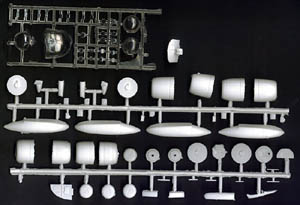 The clear parts are just about unusable. The 22 or so small round or square windows might be workable. The big question on these is going to be fit. The three turrets might also be workable with a lot of extra effort to scratch build interiors and polish and clean up the clear parts. The cockpit canopy appears to me to be just about totally unusable. It is too round in shape, has round windscreen windows where they should be flat, huge frames everywhere that don’t seem accurate and is about 1/16th inch thick. Perhaps all this would not be so bad if it was marginally clear. It looks like it was chipped out of a chunk of ice. Fixing this may be the most difficult part of the whole kit. While there is plenty of plastic to work with here, I have no idea how to polish out the reshaped canopy. My previous efforts with Mach 2 canopies have not been very successful. Maybe a master for a new vac canopy is the answer. The clear parts are just about unusable. The 22 or so small round or square windows might be workable. The big question on these is going to be fit. The three turrets might also be workable with a lot of extra effort to scratch build interiors and polish and clean up the clear parts. The cockpit canopy appears to me to be just about totally unusable. It is too round in shape, has round windscreen windows where they should be flat, huge frames everywhere that don’t seem accurate and is about 1/16th inch thick. Perhaps all this would not be so bad if it was marginally clear. It looks like it was chipped out of a chunk of ice. Fixing this may be the most difficult part of the whole kit. While there is plenty of plastic to work with here, I have no idea how to polish out the reshaped canopy. My previous efforts with Mach 2 canopies have not been very successful. Maybe a master for a new vac canopy is the answer.
The instruction sheet is brief and to the point. The single 8.5 X 11inch page has nine illustrations on one side and the three paint options on the backside. The nine exploded diagrams are very simple, but probably are enough to get the job done. They are about equally divided between pointing out variations between versions and actual assembly. An interesting side note is that the instructions never show assembly of major components. No gluing the fuselage together, no wings to body or engines to wings. Just small details. The painting instructions are equally brief. Instructions are provided (?) for two PBM-3s and one PBM-5. One really aggravating note with the decals is that while they provide the markings info for a British Coastal Command bird, the only decals provided for it are the serial, individual aircraft letter and a couple of red and black lines. If you choose to do this bird you have to find the roundels and fin flash somewhere else. I am not sure this omission is a big deal, as the rest of the decal sheet only provides simple items like national insignias, some simple white lettering and a few red warning stripes. They appear to be fuzzy around the edges and too thick 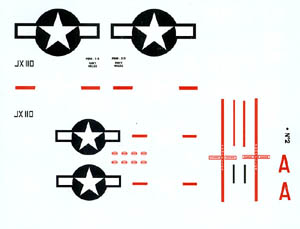 Two minor items caught my eye as I was playing with the parts. The first is the props. Many early versions had three bladed props. The kit only provides the later four bladed props. The provided four blade props seem somewhat anemic to me. The R-2600 and latter R-2800 engines were big and used large props. Especially the R-2800. This is the engine that powered the P-47, the Black Widow, the A/B-26 Invader and the C-46. In each case the props were big healthy clubs. The kit provided props seem too small and delicate of shape to be proper. They do have the right general shape, just too small in appearance and diameter. Two minor items caught my eye as I was playing with the parts. The first is the props. Many early versions had three bladed props. The kit only provides the later four bladed props. The provided four blade props seem somewhat anemic to me. The R-2600 and latter R-2800 engines were big and used large props. Especially the R-2800. This is the engine that powered the P-47, the Black Widow, the A/B-26 Invader and the C-46. In each case the props were big healthy clubs. The kit provided props seem too small and delicate of shape to be proper. They do have the right general shape, just too small in appearance and diameter.
The other minor note is the four small “winglets” that are on the tops and bottoms of the horizontal stabilizers. These butt up against the verticals and apparently helped with airflow. Good pictures are difficult to find in this area, but I think the short arrowhead shaped parts should be longer. Conclusions OK, we have thrashed (trashed?) around in the box enough. What are my conclusions? There are some significant improvements in this latest Mach 2 offering. Surface detail and general shape are much improved. Warts and blemishes are still there at times, but not as noticeable. General accuracy and crispness of small parts is also somewhat improved but still need work. You can expect to throw away a lot of the small detail stuff and either hit the spares box or scratch build replacements. This is especially true of the cockpit interior, and the turrets. I think the general shape of the model is accurate. Barring major assembly problems, it should provide the basis for a very impressive finished model. Major work will be required to solve the canopy problem, and find enough decals to do this big beast justice. Also clean up and work on sharpening the details here and there will result in a model that will be very impressive. The painting and markings options this kit provides are a very casual pass at what could have been a stunning offering. This bird flew in just about every WWII and post war scheme imaginable. It started out in the Yellow wings and silver fuselage pre war era, then went to two-tone gray, then two blues/white, and ended the war in overall sea blue. Somewhere in there is also the white/gray anti submarine patrol scheme of the South Atlantic and British Coastal Command. Post war includes the Netherlands and U. S. Coast Guard in overall silver, and even one in what appears to be Sea Blue with interesting, curved white upper fuselage. That scheme would normally be Seaplane Gray rather than the Sea Blue, but I suspect this one was blue. It is not often that one model can represent every scheme used by the Navy throughout the war. At nearly $70.00 it is seriously overpriced compared to other kits of comparable size. I think most of us recognize that these “limited run” kits cost more, but this borders on too much. The overall quality is improved over previous Mach 2 offerings, but still comes up short in several areas. If you want to add a Mariner to your display shelves the selection is limited to scratch build it; use the old Rareplanes kit if you can find it, or this one. Incidentally, the Rareplanes canopy will not even come close to fitting the Mach 2. Which is right? I don’t know. One final comment. Why do we continue to get resin and vac canopies for kits that really don’t need the extra help? Kits that really need the help are consistently being ignored? A good resin interior and a replacement Squadron/Falcon canopy for this one sure would be nice. Squadron apparently now has “exclusive” import rights to Mach 2 kits. Why not make an “exclusive” resin interior and Vac clear parts to help sell the kit? I am not ready to take Mach 2 out of the penalty box just yet. This is a big improvement over the C-123 offering, but still has a ways to go to play with the big guys. They already lead the big guys in price, but that is not a positive. If you are a serious builder, used to taking on challenges, and scratch building or adapting parts, this appears to offer a lot of potential. On the other hand if your usual stuff is the current range of excellent detailed and perfect fitting kits, this one will not be a happy experience. References The following sources were used in the preparation of this article. United States Military Aircraft Since 1908 Swanborough/Bowers, Putnam & Co. ISBN 0 370 00094 3 War Planes of the Second World War, Flying Boats (Vol 5), William Green, Macdonald. (no ISBN) Martin Aircraft 1909-1960, Breihan/Piet/Mason Thompson, ISBN 0 913322 03 2 | 


 




|
